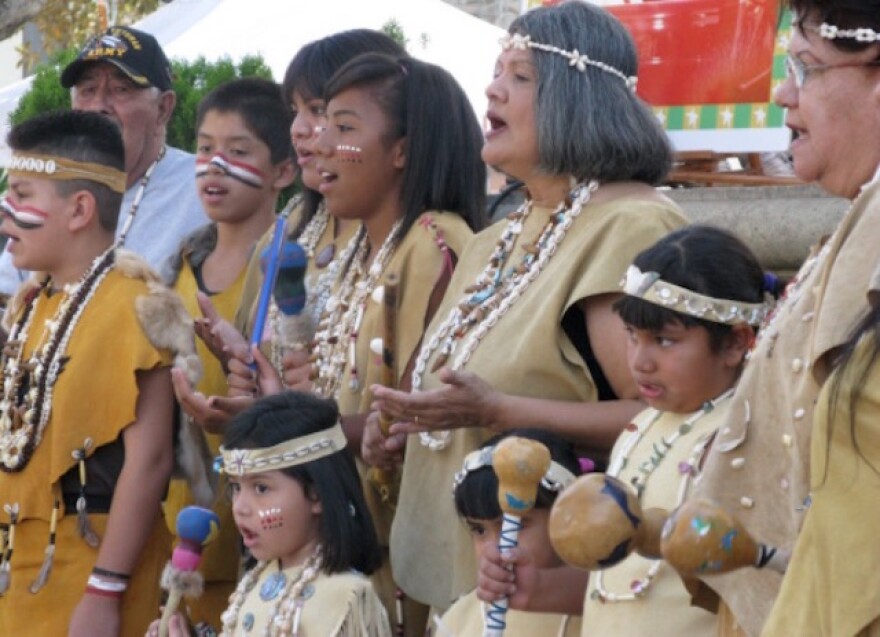Los Angeles is home to the largest indigenous population of any city in the country.
Today, some of those tribes include the Kumeyaay in Baja, the Serrano across the Mojave Desert, the Fernandeño Tataviam Band of Mission Indians in San Fernando and the the Gabrieleno Tongva people right here in the LA basin.
Some local tribes are federally recognized; others are not. Many local Native Americans are descendants of local tribes; most of them are not. Through massive displacement efforts and settler practices, Native people from tribes across the country were brought to Los Angeles and are part of the rich and complex history that makes this city so unique.
LAist's daily news program AirTalk with Larry Mantle is kicking off a new weekly series that will air Mondays on 89.3 FM looking at various aspects of SoCal history. In honor of Indigenous Peoples’ Day, we start this series with a conversation about the history and modern revitalization of indigenous culture, language, and community right here in Los Angeles.

LAist itself operates on the homeland of the Gabrieleno Tongva people in what is now Pasadena. You can find Southern California Public Radio's Land Acknowledgement here.
Long before European settlers, SoCal was bustling with Native Nations
-
Nonprofit's launching fundraiser to keep it afloat
-
USC study documents what residents want from trees
-
What candidates can — and can't — say they do
Long before the arrival of European settlers, L.A. County was home to a number of indigenous tribes. Just how long those tribes have been here is a moving target, with the date moving backward.
"Now, we're well past 10,000 years ago," said James Fenelon, a professor of sociology and director of the Center for Indigenous Peoples Studies at California State University, San Bernardino.
Fenelon said there is strong evidence supporting the presence of Native Americans 7,000 to 10,000 years ago. The contemporary nations that we know today date back 1,000 to 3,000 years.
The arrival of European settlers brought the construction of Spanish missions from San Francisco all the way to San Diego. The religious outposts served to evangelize indigenous people and expand the colonialist agendas. In addition to missionaries, indigenous people were forced into settlements know as "reductions."

"There were rebellions at every single mission," Fenelon reminded us, with one of the largest taking place at the San Gabriel Mission in modern day Alhambra. The rebellions came as a result of massive oppression, rampant sexual assaults and the attempted destruction by the mission systems of subordinate indigenous culture and way of life.
Reviving Native traditions and culture
There has been an increasing push over the last several years for more thoughtful recognition of Native peoples and more accountability on behalf of government agencies for the harm they've caused. In 2020, the Land Back movement gained momentum when then President Trump visited Mt. Rushmore and gave a divisive speech. In 2022, following allegations of abuse and erasure of indigenous peoples in Canada, Pope Francis went on what he called a "Pilgrimage of Penance" and issued an apology for the Catholic Church's role in establishing residential boarding schools where so many of the horrors inflicted upon indigenous people took place. And in 2021, President Biden declared what is now formerly known as "Columbus Day" as "Indigenous People's Day."

Kimberly Morales Johnson is the tribal secretary for the Gabrielino-Tongva San Gabriel Band of Mission Indians. She said keeping their story front and center is not just about maintaining visibility but reclaiming and revitalization their traditions and values. "Due to colonization, our people were stripped apart, moved around from mission to mission," she said. So trying to instill "traditional values" in this next generation is of utmost importance, she added.
Morales Johnson recommends the books "The First Angelinos" by William McCawley and his follow up book "O, My Ancestor" for those looking for educational resources. While the culture and physical presence in indigenous people in Los Angeles and beyond has been shattered, leaders, educators and activists are reminding us of just how deeply woven into the fabric of our city their stories are and always have been.







